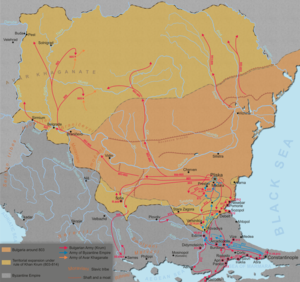
Back Битка при Версиникия Bulgarian Batalla de Versinícia Catalan Schlacht von Adrianopel (813) German Batalla de Versinikia Spanish Bataille de Versinikia French Verszinikiai csata Hungarian Battaglia di Versinicia Italian ヴェルシニキアの戦い Japanese ვერსინიკიის ბრძოლა KA Битка кај Версиникија MK
This article has multiple issues. Please help improve it or discuss these issues on the talk page. (Learn how and when to remove these messages)
|
| Battle of Versinikia | |||||||
|---|---|---|---|---|---|---|---|
| Part of the Byzantine–Bulgarian wars | |||||||
 Bulgaria under Khan Krum including the most important campaigns and battles | |||||||
| |||||||
| Belligerents | |||||||
| Bulgarian Empire | Byzantine Empire | ||||||
| Commanders and leaders | |||||||
| Kanasubigi Krum | Michael I Rangabe | ||||||
| Strength | |||||||
| 6,000–7,000[1] or 12,000[2] |
20,000[3]–30,000[2] 30,000–36,000[4] | ||||||
| Casualties and losses | |||||||
| Unknown | 2,000–3,000[5] | ||||||
The Battle of Versinikia (Bulgarian: Битката при Версиникия; Greek: Μάχη της Βερσινικίας) was a battle fought in 813 between the Byzantine Empire and the Bulgarian Empire, near the city of Adrianople (Edirne), in modern-day Turkey.
The Bulgarian army, led by Krum of Bulgaria, defeated the Byzantine forces. Following the defeat, Michael I Rangabe abdicated, with Leo V the Armenian taking the Byzantine throne.[6] The battle served to solidify the Bulgarian position after their victory over Nikephoros I two years earlier. After the battle, the Bulgars controlled the whole region of Eastern Thrace (until the Byzantine–Bulgarian Treaty of 815), with the exception of a few castles that remained in Byzantine control. Krum at the height of his assembly for the final siege of Constantinople died on 13 April 814, but his muster of: "5,000 iron-plated wagons [ . . . ] to carry the siege equipment."[7] Terrified the court of the Byzantines to such an effect that they pleaded for the aid of the Carolingian Emperor Louis the Pious;[8][9] These extensive preparations were Krum's attempt to avenge his impotent failure at the Second Bulgarian Siege of Constantinople one year prior.
- ^ Panos, p. 37
- ^ a b Haldon 2001, pp. 76–77
- ^ Panos, p. 237
- ^ Hupchick, p. 96
- ^ Hupchick, p. 101
- ^ LUTTWAK, EDWARD N. (2009-11-15). The Grand Strategy of the Byzantine Empire. Harvard University Press. doi:10.2307/j.ctvjhzrf5. ISBN 978-0-674-05420-2.
- ^ Božilov, Ivan (1999). Božilov, Ivan; Gjuzelev, Vasil (eds.). Istorija na srednovekovna Bălgarija: VII - XIV vek [History of medieval Bulgaria: VII - XIV century]. Istorija na Bălgarija : v tri toma (Izd. 1 ed.). Sofija: Izdat. Kăšta Anubis. p. 138. ISBN 978-954-426-204-4.
- ^ Fine, John Van Antwerp (1987). The Late medieval Balkans: a critical survey from the twelfth century to the Ottoman conquest. Ann Arbor: University of Michigan press. p. 99. ISBN 978-0-472-10079-8.
{{cite book}}: CS1 maint: date and year (link) - ^ Božilov, Ivan (1999). Božilov, Ivan; Gjuzelev, Vasil (eds.). Istorija na srednovekovna Bălgarija: VII - XIV vek [History of medieval Bulgaria: VII - XIV century]. Istorija na Bălgarija : v tri toma (Izd. 1 ed.). Sofija: Izdat. Kăšta Anubis. pp. 140–141. ISBN 978-954-426-204-4.